TAGGED: fatigue, fatigue-analysis, ncode
-
-
February 23, 2024 at 6:40 pm
Jeonee
SubscriberHi,
I need your opinions for a fatigue analysis of a project I will be doing. I created a aircraft wing and its lugs, so I want to do fatigue analysis of lugs which is aluminium. I will use nCode DesignLife for this analysis.
I made an analysis for wing in 1g condition, and I got stress for lugs. I think that this wing will not be affected as only 1g, so I created randomly time-g graph (below the paragraph)
I added it in nCode DesignLife SN TimeSeries, however I'm not sure that it is true method.
When I add the g-time inputs into the nCode DesignLife, how can the program calculate the life? Does it multiply the g forces corresponding to each second with the stress value in the stress analysis?
-
February 26, 2024 at 2:33 pm
danielshaw
Ansys EmployeeThe Time Series Load Provider multiplies the FE calculated stress results (usually for a unit load) by the multipliers in the time series file to create a stress history. Associating the multipliers in the time series file with an actual physical time is common, but not required. For your example, the first stress point for the fatigue evaluation would be the FE stress*2, the 2nd stress point would be the FE stress*1.2, the 3rd stress point would be the FE stress*1.25, etc. Thus, the combination of the FE stresses and the time series file create a stress history.
Are you using the Mechanical embedded Ansys nCode Designlife Add-On? If not, and you are using Mechanical 23R1 or later, I would recommend trying it.
-
February 26, 2024 at 7:07 pm
Jeonee
SubscriberThank you so much
-
-
- The topic ‘Fatigue Analysis Method’ is closed to new replies.



-
1997
-
897
-
599
-
591
-
418

© 2025 Copyright ANSYS, Inc. All rights reserved.






